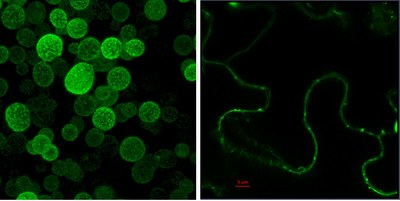The Solanaceous Sucrose Transporter Lab
The sucrose transporter gene family: structure and physiological function
Sucrose is the most prevalent sugar translocated over long distances in higher plants. The main sucrose transport flow takes place in the phloem, which connects photosynthetically active organs such as green leaves with heterotrophic tissues, which need to be supplied with fixed carbon in the form of photoassimilates. Sucrose transport has been studied in a broad variety of plant species and sucrose uptake has often been described as a biphasic transport system. In angiosperms the kinetic of sucrose uptake is comprised of two components with different kinetic properties. In isolated sieve element protoplasts, the sucrose-induced depolarization of the sieve element plasma membrane shows biphasic kinetics, arguing for the presence of at least two different sucrose-transporting systems in phloem sieve elements (Hafke et al., 2013).
Phylogenetic analysis showed that all known sucrose transporters and sucrose transporter-like proteins fall into five subgroups. The analysis of sucrose transporters has shown that the classification in these five major subgroups is not simply based on sequence homologies but also reflects substrate affinity and function of the single members.
Our objectives are to characterize the function and regulation of all sucrose transporters in Solanaceae by functional analysis in heterologous systems. Genetic approaches such as RNA interference and overexpression aiming at manipulation of fluxes in transgenic plants are used.
Another aim is to identify interacting partners of sucrose transporters. In order to gain insight into the regulation and coordination of sucrose transporter expression we are studying in vivo dynamics and function of interactions in planta by confocal laser scan microscopy using specific antibodies as well as specific fluorescent labeling techniques.

Studying substrate-induced endocytosis of sucrose transporters
The Solanum tuberosum sucrose transporter StSUT1 is localized in membrane microdomains and able to undergo endocytosis. Endocytosis of StSUT1 is substrate-inducible and occurs in an actin-dependent manner (Liesche et al., 2010; Eggert et al., 2015). Our analysis revealed a strong link between SUT1 raft localization, the sterol composition of the plasma membrane, and the capacity of the SUT1 protein to be internalized by endocytosis. Future work will elucidate the role of dimerization, phosphorylation and microdomain-association of StSUT1 for endocytosis, signaling and transport activity.

Looking for the pH sensor of StSUT1 by site-directed mutagenesis
The pH optimum of the Solanum tuberosum sucrose transporter StSUT1 was experimentally determined to range at an unexpectedly low pH of 3 or even below. Site directed mutagenesis provides information about functional amino acids, which are highly conserved and responsible for this extraordinary increase in transport capacity under extreme pH conditions (Krügel et al., 2013).
Plant sucrose transporters are regulated via phosphorylation and dephosphorylation. Identification of phosphorylation sites within the StSUT1 sequence will clarify whether phosphorylation/dephosphorylation is required for dimerization and/or endocytosis of the transporter. Redox-dependent dimerization of the StSUT1 protein in planta and in heterologous expression systems such as Saccharomyces cerevisiae, Lactococcus lactis and Xenopus leavis probably involves highly conserved cysteine residues. The accessibility of regulatory amino acid residues in the light of StSUT1's compartmentalization in membrane microdomains should thereby not be ignored.

The role of sucrose accumulation in response to abiotic stresses
StSUT1 is known to interact with several stress-inducible proteins: Snakin1 and StPDI1 and other SUT-interacting proteins are stress-inducible proteins affecting the redox homeostasis if plants are exposed to drought, salt, or cold stress. Transgenic plants with reduced StPDI1-expression show severely reduced stress tolerance. Down-regulation of StPDI1 or Snakin1 expression results in a misbalance of antioxidants, redox metabolites and metabolites of the TCA cycle (Eggert et al. 2015). The protein-protein interaction network of sucrose transporters thereby provides interesting insights about the regulatory interplay between the sugar status and redox control in stress responses.

Sucrose transporters involved in biotic interactions
Sucrose transporters are also involved in the carbohydrate supply of root symbionts such as arbuscular mycorrhizal fungi. Down-regulation of sucrose transporter SlSUT2 expression in transgenic tomato plants increased mycorrhizal colonization of roots (Bitterlich et al., 2014). Several of the interaction partners of the sucrose transporter SlSUT2 from tomato are involved in brassinosteroid synthesis, signaling or perception. The direct interaction of sucrose transporters and components of the brassinosteroid signaling pathway raises the question whether brassinosteroids and sugars jointly affect plant symbiotic interactions. The number of BR receptors and sucrose transporters at the plasma membrane relies on endocytosis, recycling and degradation of these proteins. Studying vesicular membrane trafficking deserves considerable attention within the cross-talk between these two signaling pathways.

The role of SUT4 in flower and tuber induction
Depending in the mechanisms of phloem loading, the SUT4 proteins from different plant species seem to fulfil different functions. Down-regulation of SUT4 expression has different consequences in rice, poplar, Arabidopsis or potato and SUT4 proteins have been assigned to different cellular compartments (Chincinska et al., 2013). It cannot be excluded that SUT4 proteins, as shown for SUT1 and SUT2, undergo subcellular trafficking and therefore belong to different cellular compartments.
In SUT4-inhibited transgenic plants, transcription of ethylene biosynthetic enzymes and ethylene biosynthesis are reduced. The plants seem to be far-red insensitive in artificial shading experiments and do not show shade avoidance symptoms. They flower and tuberize earlier than wild-type plants. Altogether, there must be a phloem-mobile signal that is generated in leaves in a phytochrome-dependent manner moving in the phloem over long distances towards apical meristems. Thereby sucrose - via the sucrose transporter SUT4 - is essential for the generation of this leaf-derived signal.

